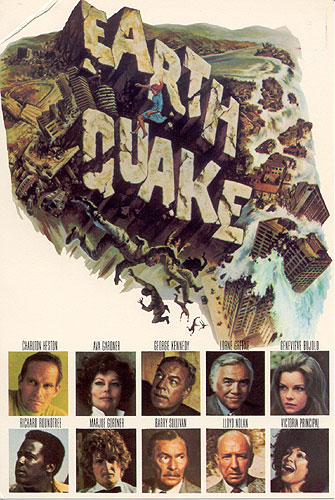Introduction to Sensurround |
Read more
at in70mm.com The 70mm Newsletter |
| Written by: From the Sensurround manual | Date: March 18, 2004 |
 The Sensurround Model II system developed by MCA Universal brings a new dimension to the motion picture theatre. It is designed to generate special audible and sub audible effects not yet possible to reproduce on presently available systems. The audience will actually be participating in the film. The torso will vibrate. So will the diaphragm. Flesh and auditory nerves will receive the sensations one might feel while experiencing the event depicted on the screen. Rather than the structure-shaking resulting from a natural disaster, this vibrating movement is actually airborne. Although some vibration can be felt - on thin wall surfaces, the amplitude is so small that no appreciable displacement can be measured. Also, the Sensurround effects will not cause hearing damage. The system is composed of high-level electro-acoustic with solid-state power amplifiers capable of up to 1000 watts of audio power. The system develops 100 to 120 dB sound pressure level (SPL) on the "C" scale in the theatre. The Sensurround Model II system developed by MCA Universal brings a new dimension to the motion picture theatre. It is designed to generate special audible and sub audible effects not yet possible to reproduce on presently available systems. The audience will actually be participating in the film. The torso will vibrate. So will the diaphragm. Flesh and auditory nerves will receive the sensations one might feel while experiencing the event depicted on the screen. Rather than the structure-shaking resulting from a natural disaster, this vibrating movement is actually airborne. Although some vibration can be felt - on thin wall surfaces, the amplitude is so small that no appreciable displacement can be measured. Also, the Sensurround effects will not cause hearing damage. The system is composed of high-level electro-acoustic with solid-state power amplifiers capable of up to 1000 watts of audio power. The system develops 100 to 120 dB sound pressure level (SPL) on the "C" scale in the theatre.The amplifiers that power the electro-acoustic transducers are provided with programmed signals from a specially recorded sound track that contains frequencies below audible range as well as within the lower audible frequency range. The Sensurround electro-acoustic transducers reproduce very low frequency components intentionally recorded on the sound track. These frequencies are too low to reproduce efficiently on theatre speaker systems. Sensurround transducers in the front and rear of the theatre are energized with the low frequencies of the sound track when commanded by special control tones recorded on the sound track. |
Further
in 70mm reading: Sensurround Horror Stories About Sensurround Sensurround @ the Schauburg Internet link: |
Using This Manual |
|
|
This manual has been written to make your job easier by providing you with step-by-step instructions for installation, servicing and removal of equipment. It also gives you guidance on the job you are to do and the support you will receive from others participating in the program. So you'll have an overview of your job, we suggest you read it cover to cover before beginning to install Sensurround. Then, as you begin the job, read the manual line by line and follow the instructions. You may even wish to physically check off each duty performed. By following this manual, you should be able to get your Sensurround system installed with a minimum of effort. In order to create the low frequency Sensurround effect theatres, the Sensurround Model II system incorporates he following features: A. Low frequency effects are recorded directly on the optical track eliminating need for an effects generator in each theatre. B. Sound track is DBX encoded to give wider frequency response and dynamic range. C. Large horns which are very efficient at low frequencies are placed in the theatre. These are driven by amplifiers and special control electronics provided with the system. D. Front and rear Sensurround horns are separately energized for more variation of effect. In order to insure adequate low frequency performance of projector sound systems, Sensurround Model II control electronic contains two preamplifiers designed to operate rom Solar-cell-equipped sound heads. Semiconductor sound pickups (ANAPFET, Photoverter, etc.) may be adapted by allowing modification instructions furnished later in his book. Theatres having older vacuum photocells will be supplied solar cell conversion kits with the Sensurround equipment. The solar cell kits are designed to permanently replace the older cells, and may be left in theatres after the Sensurround equipment is removed. Pictures released in Sensurround Model II will have sound tracks encoded Using DBX Curve 2 equipment. This is a noise-reduction system which by lowering the effect of optical sound track noise permits a much wider dynamic range to be reproduced. The increased range is used to enhance low frequency effects specially recorded on the sound track to yield powerful Sensurround sensations in the theatre. The noise-reduction property of the DBX system also permits removal of the "Academy Roll Off" Curve which has been imposed on all optical release prints for the past forty years, and better quality sound will be available in Sensurround Model II pictures. Another refinement incorporated in the Sensurround Model II system is independent control over signals routed to front and rear sets of Sensurround horns. This is obtained through 25 and 35 Hz control tones dubbed into the sound track at low level. Much of the time, the front Sensurround horns are activated to give low frequency support to the theatre speakers behind the screen. The front set of Sensurround horns should be as close to the center of the screen as possible. |
|
|
Go: back
- top - back issues
- news index Updated 22-01-25 |
|
